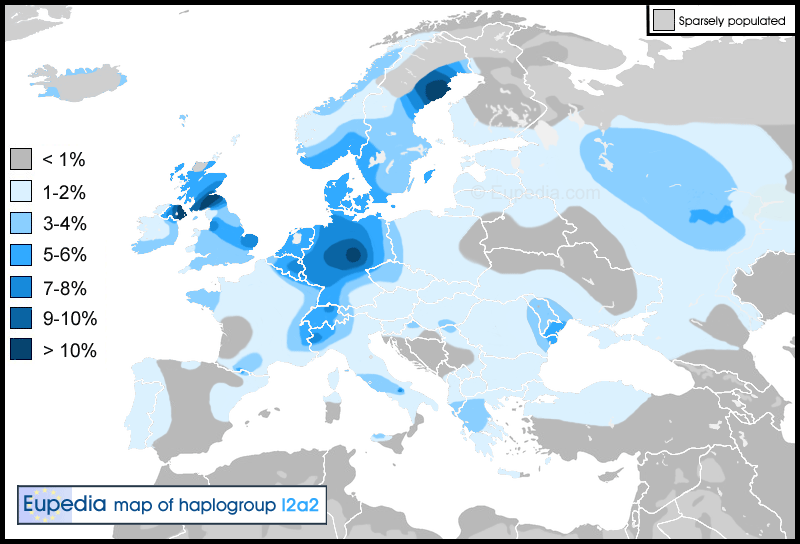MOESAN
Elite member
- Messages
- 5,888
- Reaction score
- 1,294
- Points
- 113
- Location
- Brittany
- Ethnic group
- more celtic
- Y-DNA haplogroup
- R1b - L21/S145*
- mtDNA haplogroup
- H3c
just a remark (maybe I did it before?)
the Maciamo maps (much thanks to him) are precious for hotspots and general concentration of some Hgs but they have the same defect as all maps: the question of limit: the change of colour is very impressive and we are tempted to consider as very different regions which are in two different colours: it recall me somebody here claiming today Welshmen had much more Y-G2a than other British: but in fact as a whole they have only 2,5% of it, which does not make Wales a "hotspot" of Y-G; but as they were in company of 5% other regions...
an other defect of maps: we lack numerous enough detailed regional studies so I suppose Maciamo is obliged to "complete" poorly known regions by creating some gradual decreases or increases without more precise knowledge about them: (I think by instance in France where regional studies are very scarce)
I'm sure it will improve when we have more better sampled small regions studied everywhere (it needs time) whan we can see the impact of valleys, mountain passes and natural obstacles, regional chiefferies a.s.o.
I wait the coming maps of Maciamo! do not forget too History is running on and never stops even if founders events occurred more at ancient times than at modern times
I agree too with the thought that some Y-I2a2 -L38 (I2b here!) rambled along with Y-R1b-U152 with late Celtic tribes: the distribution in Brittain fits well enough this story (E-England and Scotland by instance) - other subHG (SNPs) of these two Hgs were send there by Germanic people (Anglo-Saxons for the most but some Danish people too) because the remnants of Celts and Belgae involved at Iron Ages were surely partially inbodied as mergins people in these germanic following colonisations of the 5° centuries - for the other subgroup of I2a2 more centered around Denmark I reserve my opinion but the explanations of Maciamo could be right... I wait more data from some eastern and southern regions
the Maciamo maps (much thanks to him) are precious for hotspots and general concentration of some Hgs but they have the same defect as all maps: the question of limit: the change of colour is very impressive and we are tempted to consider as very different regions which are in two different colours: it recall me somebody here claiming today Welshmen had much more Y-G2a than other British: but in fact as a whole they have only 2,5% of it, which does not make Wales a "hotspot" of Y-G; but as they were in company of 5% other regions...
an other defect of maps: we lack numerous enough detailed regional studies so I suppose Maciamo is obliged to "complete" poorly known regions by creating some gradual decreases or increases without more precise knowledge about them: (I think by instance in France where regional studies are very scarce)
I'm sure it will improve when we have more better sampled small regions studied everywhere (it needs time) whan we can see the impact of valleys, mountain passes and natural obstacles, regional chiefferies a.s.o.
I wait the coming maps of Maciamo! do not forget too History is running on and never stops even if founders events occurred more at ancient times than at modern times
I agree too with the thought that some Y-I2a2 -L38 (I2b here!) rambled along with Y-R1b-U152 with late Celtic tribes: the distribution in Brittain fits well enough this story (E-England and Scotland by instance) - other subHG (SNPs) of these two Hgs were send there by Germanic people (Anglo-Saxons for the most but some Danish people too) because the remnants of Celts and Belgae involved at Iron Ages were surely partially inbodied as mergins people in these germanic following colonisations of the 5° centuries - for the other subgroup of I2a2 more centered around Denmark I reserve my opinion but the explanations of Maciamo could be right... I wait more data from some eastern and southern regions


